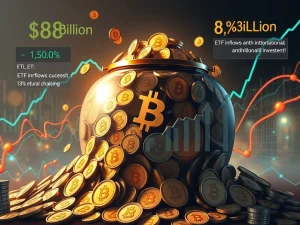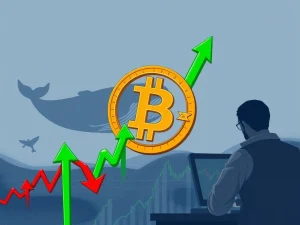Urgent: Sovereign Wealth Funds Embrace Bitcoin as Inflation Hedge

The world of finance is witnessing a notable shift. While some retail traders are stepping back from the market, major players like Sovereign wealth funds and other institutions are making a strategic move: accumulating Bitcoin. This trend highlights a growing institutional confidence in digital assets, particularly Bitcoin, as a store of value and a hedge against economic uncertainty.
Why Are Institutions Embracing Bitcoin?
According to John D’Agostino, head of strategy at Coinbase Institutional, the reason is simple: they view Bitcoin much like gold. During a recent CNBC appearance, D’Agostino explained that institutional buyers are acquiring Bitcoin as an Inflation hedge and a safeguard against macroeconomic risks. They are focusing on Bitcoin’s fundamental characteristics:
- Scarcity: Limited supply, similar to precious metals.
- Immutability: Transactions are secure and unchangeable.
- Non-sovereign asset portability: Easily moved and not tied to a single government’s currency.
These traits position Bitcoin as a compelling alternative asset, especially in times of currency devaluation and geopolitical tension.
Institutional Adoption: More Than Just Funds
The trend of Institutional adoption of Bitcoin extends beyond just sovereign wealth funds. Governments and various financial entities are exploring and implementing Bitcoin reserve strategies. Countries like El Salvador and Bhutan have already integrated Bitcoin into their national reserves. Municipalities and state governments are also considering pro-Bitcoin policies to protect treasury value from depreciating fiat currencies.
The corporate world, led by companies like MicroStrategy (now Strategy), has popularized the concept of holding Bitcoin on corporate balance sheets. This strategy, initiated by Michael Saylor, has been adopted by others including MARA, MetaPlanet, and Semler Scientific. Strategy itself has transformed, becoming a significant Bitcoin holding entity, offering both direct and indirect exposure to numerous institutions and beneficiaries.
Analyzing the BTC Price Movement
Recent market movements show Bitcoin reclaiming levels above $90,000. This price action reinforces the narrative that Bitcoin is increasingly decoupling from traditional markets, trading based on its intrinsic characteristics rather than simply tracking other assets. The focus is shifting towards its role as a non-sovereign, scarce asset. Understanding the drivers behind the BTC price is crucial for anyone following the market, and institutional accumulation is clearly a significant factor.
Bitcoin’s Growing Global Standing
Bitcoin’s market capitalization recently surpassed that of Google, positioning it among the top five assets globally, ahead of major companies like Amazon and even Silver. This milestone underscores the rapid growth and increasing recognition of this supply-capped digital asset since its inception in 2009. The sustained interest from sophisticated investors like Sovereign wealth funds contributes significantly to this growth and validation.
Key Takeaways
The current market dynamic reveals a clear divergence: institutional investors are actively accumulating Bitcoin, seeing it as a strategic long-term asset and an Inflation hedge, while some retail investors may be taking profits or reducing exposure. This institutional confidence, driven by Bitcoin’s fundamental properties and its increasing role in global finance, is a powerful signal. As more entities consider Institutional adoption, Bitcoin’s position as a significant global asset appears to strengthen, potentially impacting future BTC price trajectories.
In conclusion, the actions of sovereign wealth funds and other large institutions highlight a maturing view of Bitcoin. It’s increasingly seen not just as a speculative asset, but as a fundamental store of value and a critical component in treasury management strategies aimed at preserving wealth against economic pressures.









